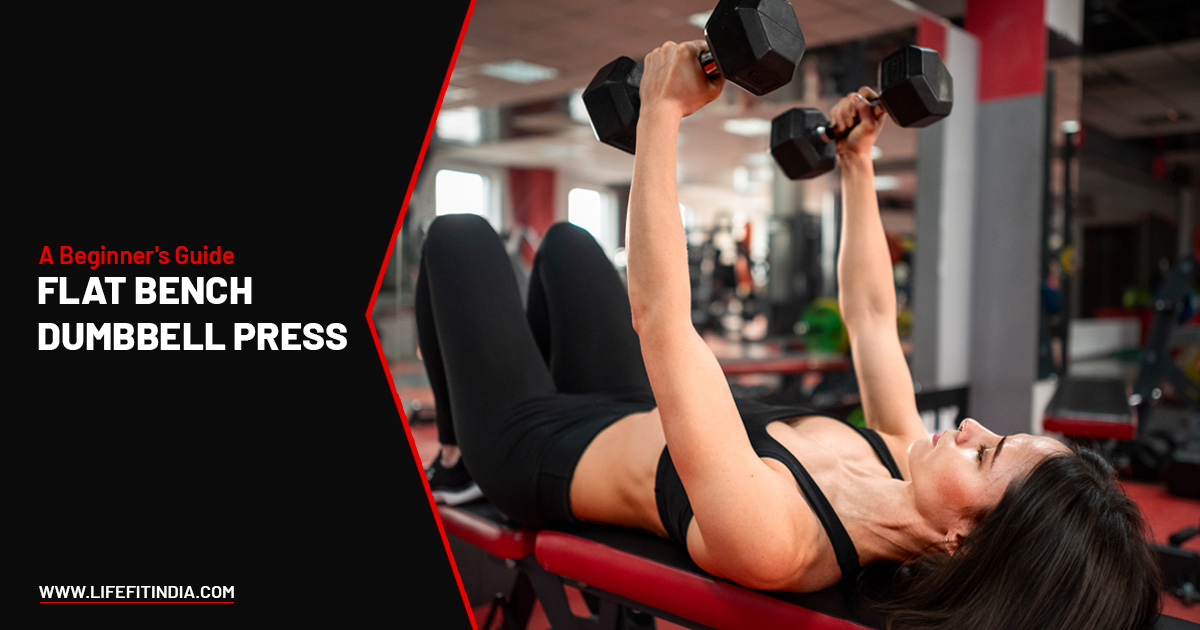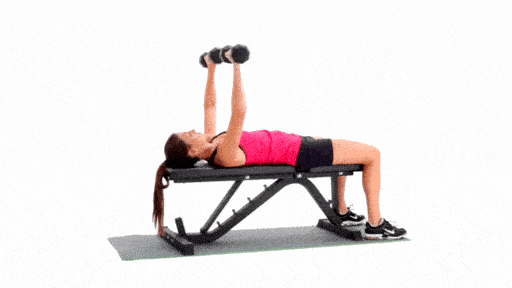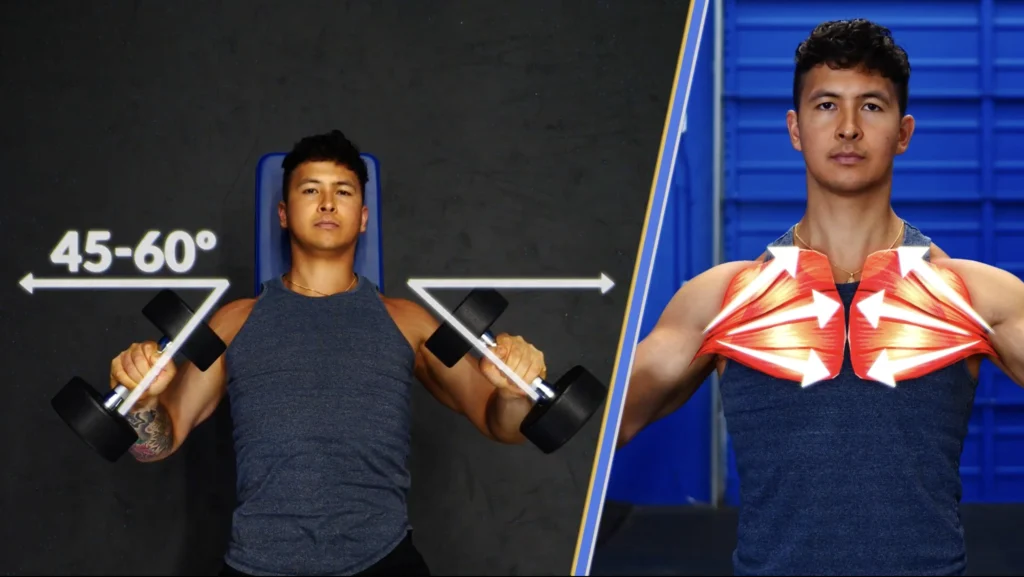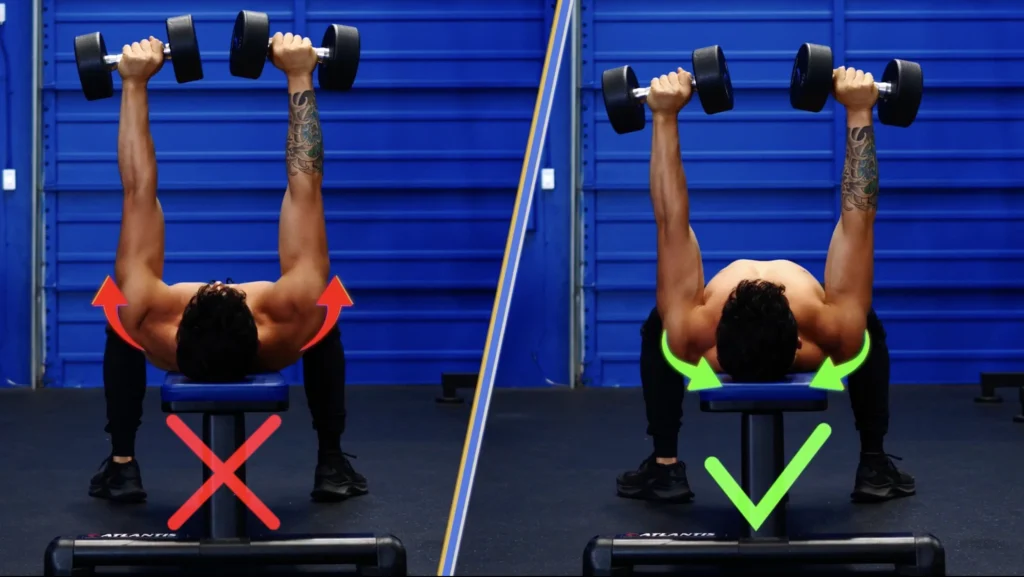Dumbbell Bench Press Exercise Guide

The dumbbell bench press stands as a cornerstone exercise for building upper body strength and muscle. It’s a versatile movement, favored by many for its unique advantages over other pressing exercises. Whether you are setting up your home gym or training in a commercial space, understanding this exercise is key. This comprehensive guide aims to be your definitive resource, covering correct form, the benefits compared to barbells, muscles worked, effective variations, common mistakes to avoid, safety procedures, and detailed programming strategies to maximize your results.
Why Choose Dumbbells? Dumbbell vs. Barbell Bench Press
A common question is how the dumbbell press stacks up against the traditional barbell bench press. While both are effective chest builders, dumbbells offer distinct advantages.
Benefits of Dumbbells:
- Greater Range of Motion: Dumbbells allow your hands to move through a larger and more natural arc, potentially leading to a deeper stretch and better activation of the chest muscles.
- More Natural Movement Path: The freedom to adjust grip and path can be easier on the shoulder, elbow, and wrist joints compared to a fixed barbell. Many find this helps with shoulder safety.
- Corrects Muscle Imbalances: Each arm must stabilize and lift its own weight independently. This highlights and helps fix strength differences between your left and right side, building balanced, unilateral strength. Explore different dumbbell types like Hex Dumbbells or Fixed Weight Dumbbells in our Dumbbells collection.
- Increased Stabilizer Activation: Controlling two separate weights forces the smaller stabilizing muscles in your shoulders and core to work harder.
- Enhanced Safety (Especially Solo): If you reach muscle failure, you can usually drop dumbbells safely to the sides. This is harder and riskier with a barbell, especially when training alone.
While barbells allow for lifting heavier absolute loads, dumbbells are invaluable for muscle growth, joint health, and balanced development. Many successful workout routines incorporate both.
Muscles Worked During the Dumbbell Bench Press

This exercise effectively targets several upper body muscles.
Primary Movers:
- Pectoralis Major: The main chest muscle, responsible for pushing the weights away from your body (horizontal adduction).
- Anterior Deltoid: The front portion of your shoulder muscle assists in the pressing motion (shoulder flexion).
- Triceps Brachii: Located on the back of your upper arm, the triceps extend the elbow to lock out the press.
Secondary Movers & Stabilizers:
- Rotator Cuff: These small muscles are crucial for stabilizing the shoulder joint throughout the lift.
- Biceps: Help stabilize the arm during the movement.
- Core Musculature: Your abs and lower back work to keep you stable on the bench, especially during single arm work.
- Latissimus Dorsi (Lats): Your back muscles help stabilize the shoulder blades, creating a solid platform to press from.
How to Perform the Dumbbell Bench Press: Perfect Form Guide
Mastering the form is crucial before increasing the weight. Start light.
Equipment Needed
- A stable bench. A Flat Bench is standard, but an Adjustable Gym Bench offers more variation. Our guide on choosing the perfect adjustable gym bench can help.
- A pair of dumbbells appropriate for your strength level.
See our article on how to maximize your workouts with dumbbells.
Step-by-Step Instructions

- The Setup: Sit on the end of the bench with dumbbells resting vertically on your thighs, palms facing each other (neutral grip).
- Getting into Position: Smoothly lie back onto the bench. As you do, use your thighs to help “kick” the dumbbells up one at a time towards the starting position over your chest. Keep the weights close to your body.
- Establishing the Starting Position: Plant your feet firmly on the floor. Maintain a slight, natural arch in your lower back, or press your back flat into the bench based on comfort and stability. Pull your shoulder blades down and back, like you’re tucking them into your back pockets (retract and depress). Hold the dumbbells directly above your shoulders or upper chest. Your palms can face forward (standard grip) or stay neutral. Keep wrists straight.
- The Descent (Eccentric Phase): Inhale and slowly lower the dumbbells under control, taking about 2-3 seconds. Keep your elbows tucked at roughly a 45 to 60 degree angle relative to your torso; avoid flaring them straight out to the sides (90 degrees). The dumbbells should follow a slight arc, ending up slightly wider than your shoulders at the bottom. Lower until the dumbbells are about level with your chest, or your upper arms are parallel to the floor, feeling a good stretch in your pecs.
- The Pause (Optional but Recommended): Pause briefly at the bottom position. This eliminates momentum and ensures you control the weight.
- The Press (Concentric Phase): Exhale forcefully and press the dumbbells back up towards the starting position. Focus on squeezing your chest muscles as you press. The dumbbells might move slightly closer together at the top, but avoid clanging them. Stop just before fully locking out your elbows to keep tension on the muscles, or achieve full lockout depending on your goals.
- Breathing Pattern: Inhale as you lower the weights, exhale as you press them up.
Video Demonstration
Common Dumbbell Bench Press Mistakes (and How to Fix Them)
Avoiding common errors is key for safety and effectiveness. Pay attention to these points and contrast the incorrect movement with the proper execution shown in the visuals.
1. Elbows Flaring Out Wide

- Why it’s bad: Increases stress on the shoulder joint (impingement risk) and reduces chest involvement.
- The Fix: Consciously keep elbows tucked closer to your body (45-60 degree angle) throughout the lift. Imagine trying to bend a bar.
2. Forearms Not Vertical
- Why it’s bad: Puts unnecessary stress on joints (wrists/elbows) and makes the lift less efficient by shifting force away from the chest.
- The Fix: Ensure your wrists are stacked directly over your elbows, particularly at the bottom of the movement. Forearms should remain perpendicular to the floor.

3. Excessive Lower Back Arch / Butt Lifting Off Bench
- Why it’s bad: Increases spinal stress, changes the angle of the press, and reduces stability.
- The Fix: Keep your core braced, press your feet firmly into the floor, and ensure your glutes stay glued to the bench throughout the set. Reduce the weight if needed to maintain this position.
4. Shoulders Rolling Forward (Protraction) at the Top
- Why it’s bad: Takes tension off the chest muscles at the peak contraction and involves other muscles excessively.
- The Fix: Keep those shoulder blades pulled down and back (retracted) for the entire repetition, even at the very top. Think “chest up” and maintain that solid base.

5. Bringing Dumbbells Too Close / Clanging at Top
- Why it’s bad: Can momentarily reduce tension on the chest as the joints stack over each other.
- The Fix: Stop the press when your arms are extended over your shoulders, maintaining a small space between the dumbbells.
6. Uncontrolled Descent / Bouncing
- Why it’s bad: Uses momentum instead of muscle, increases injury risk, and reduces the muscle-building stimulus from the negative (eccentric) phase.
- The Fix: Always control the lowering phase, aiming for about 2-3 seconds. Consider a brief pause at the bottom.
7. Incorrect Head Position (Lifting Head)
- Why it’s bad: Can strain your neck and disrupt your stable base.
- The Fix: Keep your head flat on the bench, maintaining a neutral neck position and looking straight up at the ceiling.
Dumbbell Bench Press Variations for Targeted Growth & Variety
Variations help target different muscle fibers, overcome sticking points, add variety to your training, or accommodate limitations. Using an adjustable bench
like the ones in our Benches & Racks Collection enables many of these.
Incline Dumbbell Press
- Focus: Targets the upper (clavicular) part of the chest.
- Technique: Set the bench to a 15-30 degree incline for optimal upper chest focus without excessive shoulder involvement (Rodríguez-Ridao et al., 2020). Perform the press as usual. Our Pro Series Olympic Incline Bench is built for this.
Decline Dumbbell Press
- Focus: Targets the lower (sternal) part of the chest.
- Technique: Use a decline bench, like the Pro Series Olympic Decline Bench, securing your feet properly. Perform the press with control.
Neutral Grip Dumbbell Press
- Focus: Palms face each other. Often more comfortable for the shoulder joints and may increase triceps involvement.
- Technique: Maintain the neutral grip throughout the lift.
Dumbbell Floor Press
- Focus: Performed lying on the floor. Reduces range of motion, emphasizing the top part of the press (lockout) and is generally very shoulder-friendly.
- Technique: Lower the dumbbells until your upper arms gently touch the floor, then press back up. Ensure you have adequate floor protection like a Rubber Floor Mat.
Single-Arm Dumbbell Press
- Focus: Greatly increases the challenge to your core stability and helps identify/fix strength imbalances.
- Technique: Press one dumbbell at a time, actively bracing your core to prevent your torso from rotating.
Alternating Dumbbell Press
- Focus: Increases time under tension and stability demand, allowing a brief rest for the non-working arm.
- Technique: Press one arm up while the other stays in the bottom position. Alternate arms with each rep. This is one of many effective dumbbell exercises for arms.
Programming the Dumbbell Bench Press: Sets, Reps, and Progression
How you program this exercise depends on your fitness goals. This is key for integrating it into your overall strength training at home or gym routine.
Hypertrophy (Building Muscle Mass)
- Rep Range: 6-12 reps per set is generally effective.
- Sets: 3-5 working sets per exercise.
- Rest Periods: 60-90 seconds between sets.
- Frequency: Train chest 1-2 times per week allows for recovery.
- Key Principle: Focus on good form, controlled lowering (eccentric), potentially emphasizing time under tension, and reaching muscular fatigue near the end of the set.
For Strength
- Rep Range: 3-8 reps per set typically works well.
- Sets: 3-5 working sets.
- Rest Periods: Longer rests, 2-5 minutes, for better recovery between heavy sets.
- Load: Use heavier weights, focusing on increasing the load over time (progressive overload). Consider adding quality Weight Plates to your setup.
For Muscular Endurance
- Rep Range: 15+ reps per set.
- Sets: 2-3 working sets.
- Rest Periods: Shorter rests, 30-60 seconds.
- Load: Use lighter weights.
Progression Strategies (Crucial for Long-Term Gains)
- Double Progression: Pick a rep range (e.g., 8-12). Start with a weight you can lift for 8 reps across all sets with good form. Work up to completing all sets for 12 reps. Once you achieve this, increase the weight slightly and start back at 8 reps.
- Linear Progression: Add a small amount of weight each week while keeping sets and reps the same (best for beginners learning foundational movements).
- Other Methods: You can also progress by adding sets, reducing rest time, improving form, or slowing down the tempo (increasing time under tension). Learning about different types of exercises can provide more context.
Placement in Workout Routine
The dumbbell bench press can be your main chest exercise or follow a barbell press. It fits well into chest days, upper body days, or full-body routines. Find more ideas in our Ultimate Guide to Exercise Equipment Machines.
Dumbbell Bench Press Safety Considerations
Safety first ensures consistent training and injury prevention.
- Warm-up: Always perform a general warm-up and some specific activation drills for your shoulders and chest before pressing. Consider dynamic stretches and light cardio.
- Start Light: Master the form with lighter weights before attempting heavier loads. Our Top 10 Fitness Tips for Beginners emphasizes this principle.
- Spotting: While generally safer than barbells for solo training, a spotter can provide assistance if needed, especially when pushing limits.
- Handling Weights: Learn the proper technique (kicking weights up from thighs) to get dumbbells into position and how to set them down safely, especially when fatigued. Don’t just drop them carelessly.
- Listen to Your Body: Never push through sharp pain. If something hurts, stop and assess. Seek professional advice if pain persists. Proper exercise recovery is also vital for long term progress.
Frequently Asked Questions (FAQ)
1. How much weight should I use for dumbbell bench press?
Prioritize form above all else. Select a weight that allows you to complete your target reps with good technique, feeling the muscles work. Don’t chase numbers at the expense of form.
2. Can I build a big chest using only dumbbells?
Absolutely. Dumbbells provide excellent stimulus for muscle growth due to their range of motion and stabilization demands. Combining them with other chest exercises like dips (see our Chest Dips Exercise guide) or push-ups (Push Ups Benefits) creates a well-rounded approach.
3. Is the dumbbell bench press truly safer for shoulders than the barbell?
For many individuals, yes. The dumbbells allow a more natural movement path that can reduce joint strain compared to the fixed path of a barbell. However, poor form with any exercise, including dumbbells, carries risk.
4. How can I make the dumbbell bench press harder without just adding weight?
Increase your reps or sets, slow down the lowering (eccentric) phase of the lift, shorten your rest periods, use pauses at the bottom, or employ more challenging variations like single-arm or alternating presses.
5. What's the main difference between a dumbbell press and a dumbbell fly?
A press is a compound (multi-joint) pushing movement targeting the chest, shoulders, and triceps. A fly is generally considered an isolation (single-joint) movement focusing on bringing the arms across the body (adduction), primarily targeting the chest with less direct shoulder and triceps involvement. You might use a Pec Deck Fly Machine for a similar fly motion.
Conclusion
The dumbbell bench press is a fundamental and highly effective exercise, offering significant unique benefits for building upper body strength and muscle mass. Mastering and consistently applying proper form and technique is absolutely critical for maximizing results and minimizing the risk of injury. By understanding the techniques, variations, safety considerations, and programming strategies outlined here, you can effectively incorporate this powerful movement into a well-structured training program for impressive upper body development.
Want a structured workout? Download our FREE Dumbbell Chest Workout PDF
Stay Connected: Follow us on Instagram for daily fitness tips and motivation.
Ready to upgrade your gear? Explore our full range of Strength Machines and Free Weights to equip your workout space.